Characterization of Hybrid Lightning Flashes Observed by Fast Antenna Lightning Mapping Array in Summer Thunderstorms
Abstract
1. Introduction
2. Data Processing
3. Examples of Hybrid Lightning Flashes
3.1. Hybrid A
3.2. Hybrid B
3.3. Hybrid C
4. Statistical Analysis
4.1. Parameters During the PB Process
Initiation Altitude
4.2. Parameters After the PB Process
4.2.1. Interval from the PB Initiation to the RS1st
4.2.2. Propagation Length
4.2.3. Flash Size
4.3. Parameters Associated with RS
4.3.1. RS Multiplicity
4.3.2. RS Currents
4.3.3. RS Interval
4.3.4. Radar Echo Where the RS Is Located
5. Discussion
5.1. The Formation Mechanism of Hybrid A and B Flashes
5.2. The Possible Charge Structure in Favor of Producing Hybrid C Flashes
6. Conclusions
- (1)
- The hybrid flashes have an AM initiation height of 7.1 km, lower than IC flashes (8.8 km) but apparently higher than typical CG flashes (5.9 km). Histograms show that both hybrid B and C flashes present a single peak, respectively, in the interval of [5, 6] km and [8, 8.5] km. However, hybrid A flashes show double peaks, which may be due to a small sample size.
- (2)
- During the stage of the leader progressions after the PB process, we calculated the interval and propagation length from PB to RS1st and the horizontal flash size. Relative to hybrid B flashes, hybrid A and hybrid C flashes have a larger interval (AM value: 430.3, 239.3 vs. 54.4 ms) and longer propagation length (AM value: 6.4, 7.8 vs. 3.0 km). Compared to IC and CG flashes, hybrid flashes unsurprisingly have the largest horizontal size: the AM values of hybrid A, B, and C flashes are 189, 210, and 126.9 km2, respectively.
- (3)
- Parameters associated with RS include RS multiplicity, peak currents of first and subsequent RSs, RS interval, and radar echo where the RS is located. Compared to hybrid A and C flashes, we have found that hybrid B flashes tend to produce more RSs (AM: 5.3 vs. 3.3 and 2) and larger RS1st peak currents (AM: 34.4 vs. 26.8 and 26.7 kA). Hybrid C flashes appear to be close to or out of the cloud edge, in which 29% (31/108) of them are in the regions without a radar echo. As to subsequent RS currents and RS interval, there is no significant difference after comparing the three types of hybrid flashes.
Author Contributions
Funding
Institutional Review Board Statement
Informed Consent Statement
Data Availability Statement
Acknowledgments
Conflicts of Interest
References
- Mecikalski, R.M.; Bitzer, P.M.; Carey, L.D. Why flash type matters: A statistical analysis. Geophys. Res. Lett. 2017, 44, 9505–9512. [Google Scholar] [CrossRef]
- Mecikalski, R.M.; Carey, L.D. Radar reflectivity and altitude distributions of lightning as a function of IC, CG, and HY flashes: Implications for LNOx production. J. Geophys. Res. Atmos. 2018, 123, 12796–12813. [Google Scholar] [CrossRef]
- Qie, X.; Wang, Z.; Wang, D.; Liu, M. Characteristics of positive cloud-to-ground lightning in Da Hinggan Ling forest region at relatively high latitude, northeastern China. J. Geophys. Res. Atmos. 2013, 118, 13393–13404. [Google Scholar] [CrossRef]
- Zhang, Y.; Zhang, Y.; Zheng, D.; Lu, W. Preliminary breakdown, following lightning discharge processes and lower positive charge region. Atmos. Res. 2015, 161, 52–56. [Google Scholar] [CrossRef]
- Mecikalski, R.M.; Carey, L.D. Lightning characteristics relative to radar, altitude and temperature for a multicell, MCS and supercell over northern Alabama. Atmos. Res. 2017, 191, 128–140. [Google Scholar] [CrossRef]
- Lu, G.; Cummer, S.A.; Blakeslee, R.J.; Weiss, S.; Beasley, W.H. Lightning morphology and impulse charge moment change of high peak current negative strokes. J. Geophys. Res. Atmos. 2012, 117, D04212. [Google Scholar] [CrossRef]
- Lang, T.J.; Cummer, S.A.; Rutledge, S.A.; Lyons, W.A. The meteorology of negative cloud-to-ground lightning strokes with large charge moment changes: Implications for negative sprites. J. Geophys. Res. Atmos. 2013, 118, 7886–7896. [Google Scholar] [CrossRef]
- Bitzer, P.M.; Christian, H.J.; Stewart, M.; Burchfield, J.; Podgorny, S.; Corredor, D.; Hall, J.; Kuznetsov, E.; Franklin, V. Characterization and applications of VLF/LF source locations from lightning using the Huntsville Alabama Marx Meter Array. J. Geophys. Res. Atmos. 2013, 118, 3120–3138. [Google Scholar] [CrossRef]
- Yoshida, S.; Wu, T.; Ushio, T.; Kusunoki, K.; Nakamura, Y. Initial results of LF sensor network for lightning observation and characteristics of lightning emission in LF band. J. Geophys. Res. Atmos. 2014, 119, 12034–12051. [Google Scholar] [CrossRef]
- Wu, T.; Wang, D.; Takagi, N. Lightning mapping with an array of fast antennas. Geophys. Res. Lett. 2018, 45, 3698–3705. [Google Scholar] [CrossRef]
- Krehbiel, P.R.; Riousset, J.A.; Pasko, V.P.; Thomas, R.J.; Rison, W.; Stanley, M.A.; Edens, H.E. Upward electrical discharges from thunderstorms. Nat. Geosci. 2008, 1, 233–237. [Google Scholar] [CrossRef]
- Boggs, L.D.; Liu, N.; Splitt, M.; Lazarus, S.; Glenn, C.; Rassoul, H.; Cummer, S.A. An analysis of five negative sprite-parent discharges and their associated thunderstorm charge structures. J. Geophys. Res. Atmos. 2016, 121, 759–784. [Google Scholar] [CrossRef]
- Fan, X.P.; Zhang, Y.J.; Zheng, D.; Zhang, Y.; Lyu, W.T.; Liu, H.Y.; Xu, L.T. A new method of three-dimensional location for low-frequency electric field detection array. J. Geophys. Res. Atmos. 2018, 123, 8792–8812. [Google Scholar] [CrossRef]
- Wu, T.; Smith, D.M.; Wada, Y.; Nakazawa, K.; Oguchi, M.; Kamogawa, M.; Suzuki, T.; Yang, Q.; Wang, D. Energetic compact strokes as the major source of downward terrestrial gamma-ray flashes in winter thunderstorms. Geophys. Res. Lett. 2025, 52, e2024GL113194. [Google Scholar] [CrossRef]
- Wu, T.; Wang, D.; Takagi, N. High-accuracy classification of radiation waveforms of lightning return strokes. J. Geophys. Res. Atmos. 2023, 128, e2023JD038715. [Google Scholar] [CrossRef]
- Cummins, K.L.; Wilson, J.G.; Eichenbaum, A.S. The impact of cloud-to-ground lightning type on the differences in return stroke peak current over land and ocean. IEEE Access 2019, 7, 174774–174781. [Google Scholar] [CrossRef]
- Nag, A.; Cummins, K.L. Negative first stroke leader characteristics in cloud-to-ground lightning over land and ocean. Geophys. Res. Lett. 2017, 44, 1973–1980. [Google Scholar] [CrossRef]
- Baharudin, Z.A.; Ahmad, N.A.; Fernando, M.; Cooray, V.; Mäkelä, J.S. Comparative study on preliminary breakdown pulse trains observed in Johor, Malaysia and Florida, USA. Atmos. Res. 2012, 117, 111–121. [Google Scholar] [CrossRef]
- Marshall, T.; Schulz, W.; Karunarathna, N.; Karunarathne, S.; Stolzenburg, M.; Vergeiner, C.; Warner, T. On the percentage of lightning flashes that begin with initial breakdown pulses. J. Geophys. Res. Atmos. 2014, 119, 445–460. [Google Scholar] [CrossRef]
- Shi, D.; Wang, D.; Wu, T.; Takagi, N. Correlation between the first return stroke of negative CG lightning and its preceding discharge processes. J. Geophys. Res. Atmos. 2019, 124, 8501–8510. [Google Scholar] [CrossRef]
- Bruning, E.C.; MacGorman, D.R. Theory and observations of controls on lightning flash size spectra. J. Atmos. Sci. 2013, 70, 4012–4029. [Google Scholar] [CrossRef]
- Zheng, D.; MacGorman, D.R. Characteristics of flash initiations in a supercell cluster with tornadoes. Atmos. Res. 2016, 167, 249–264. [Google Scholar] [CrossRef]
- Rakov, V.A.; Uman, M.A.; Thottappillil, R. Review of lightning properties from electric field and TV observations. J. Geophys. Res. Atmos. 1994, 99, 10745–10750. [Google Scholar]
- Zhu, Y.; Rakov, V.A.; Mallick, S.; Tran, M.D. Characterization of negative cloud-to-ground lightning in Florida. J. Atmos. Sol.-Terr. Phys. 2015, 136, 8–15. [Google Scholar] [CrossRef]
- Gao, P.; Wang, D.; Shi, D.; Wu, T.; Takagi, N. Characterization of Multitermination CG Flashes Using a 3D Lightning Mapping System (FALMA). Atmosphere 2019, 10, 625. [Google Scholar] [CrossRef]
- Edens, H. Bolts from the Blue. Doctor Thesis, New Mexico Institute of Mining and Technology, Socorro, NM, USA, 10 June 2011. [Google Scholar]
- Qie, X.; Liu, D.; Li, F.; Sun, Z.; Wei, L.; Sun, C.; Zhu, K.; Lü, H.; Tang, G.; Yuan, S.; et al. Charge structure of an isolated thunderstorm on the Tibetan Plateau and the formation of bolt-from-the-blue lightning. Chin. Sci. Bull. 2025, 70, 944–954. (In Chinese) [Google Scholar] [CrossRef]

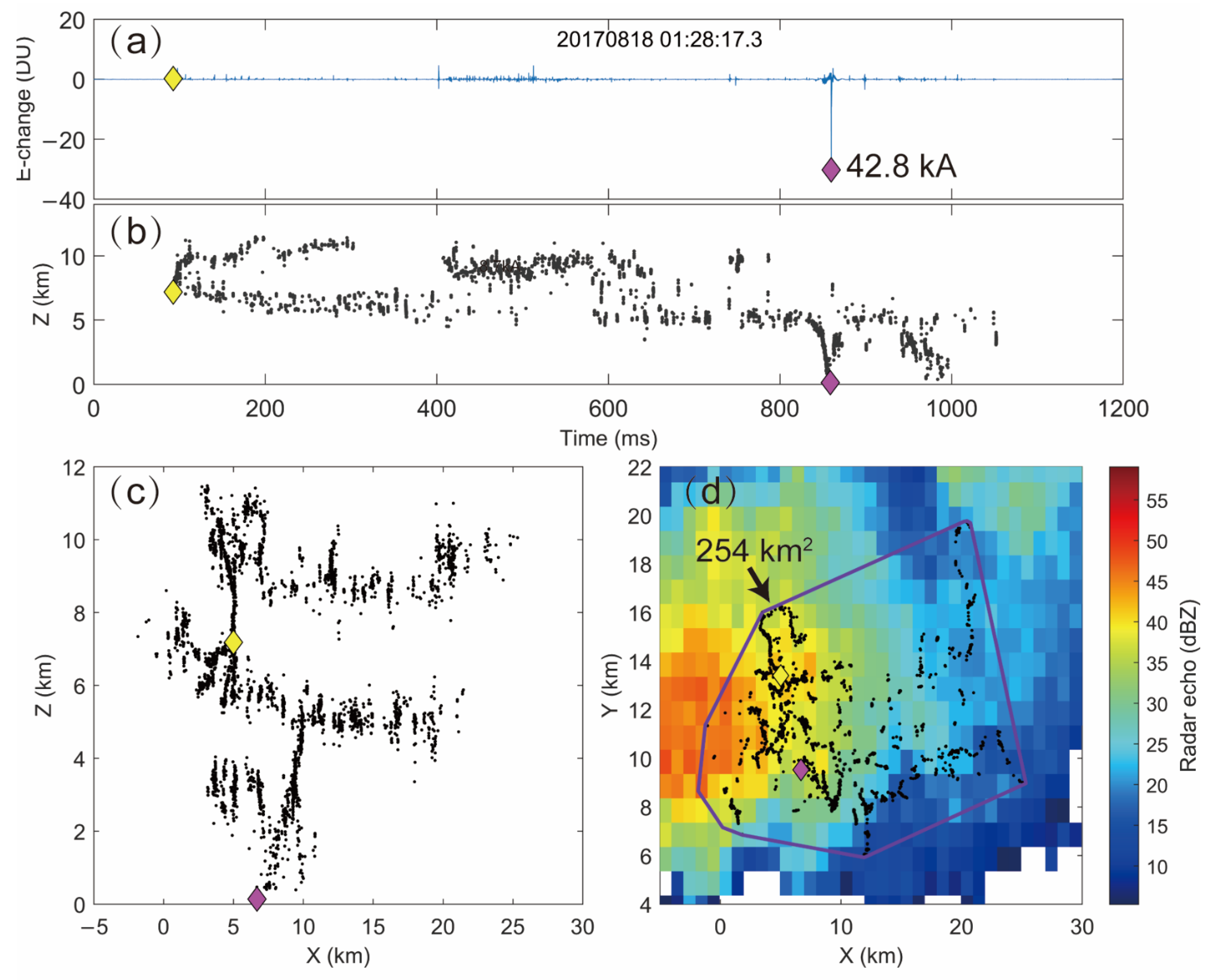

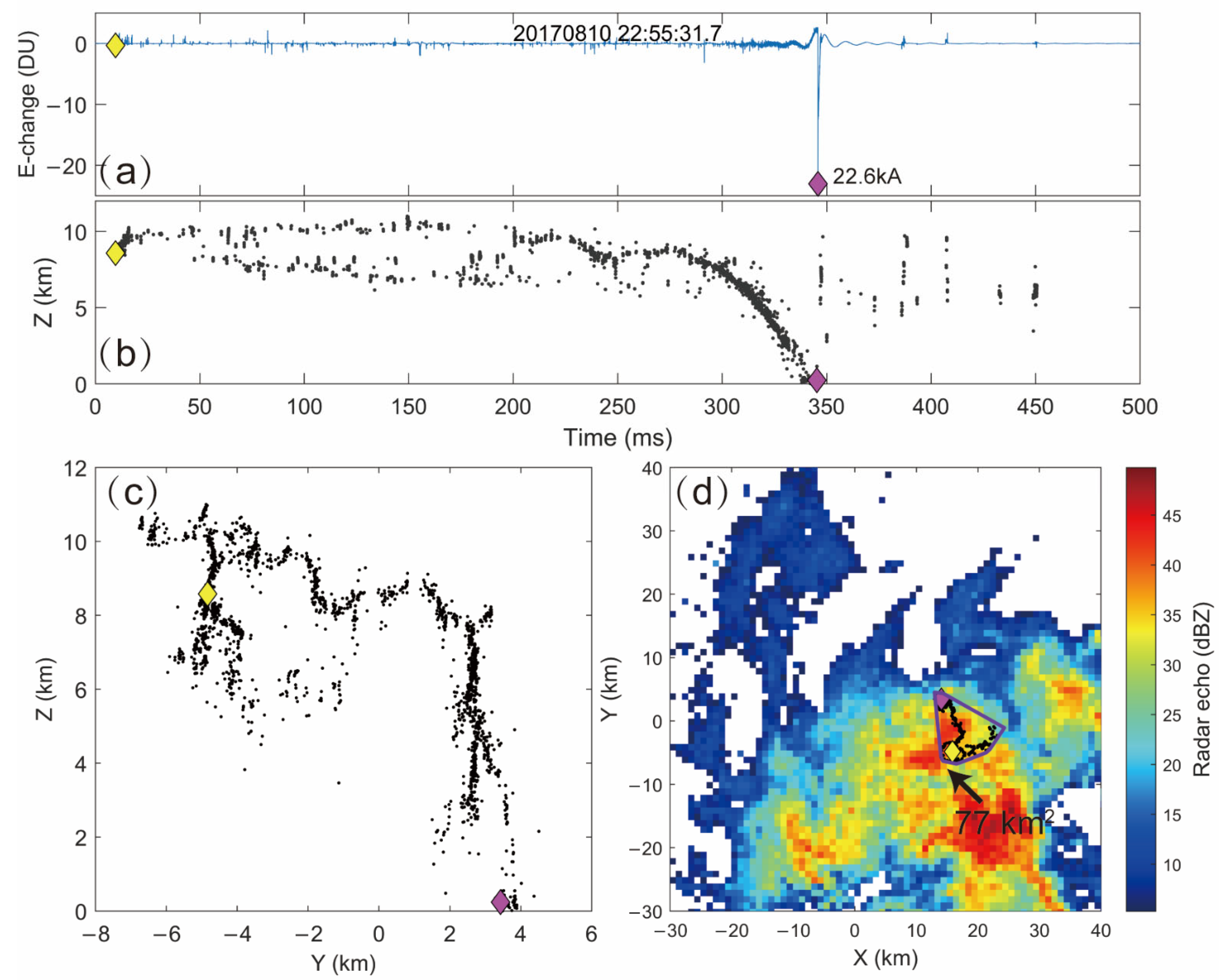


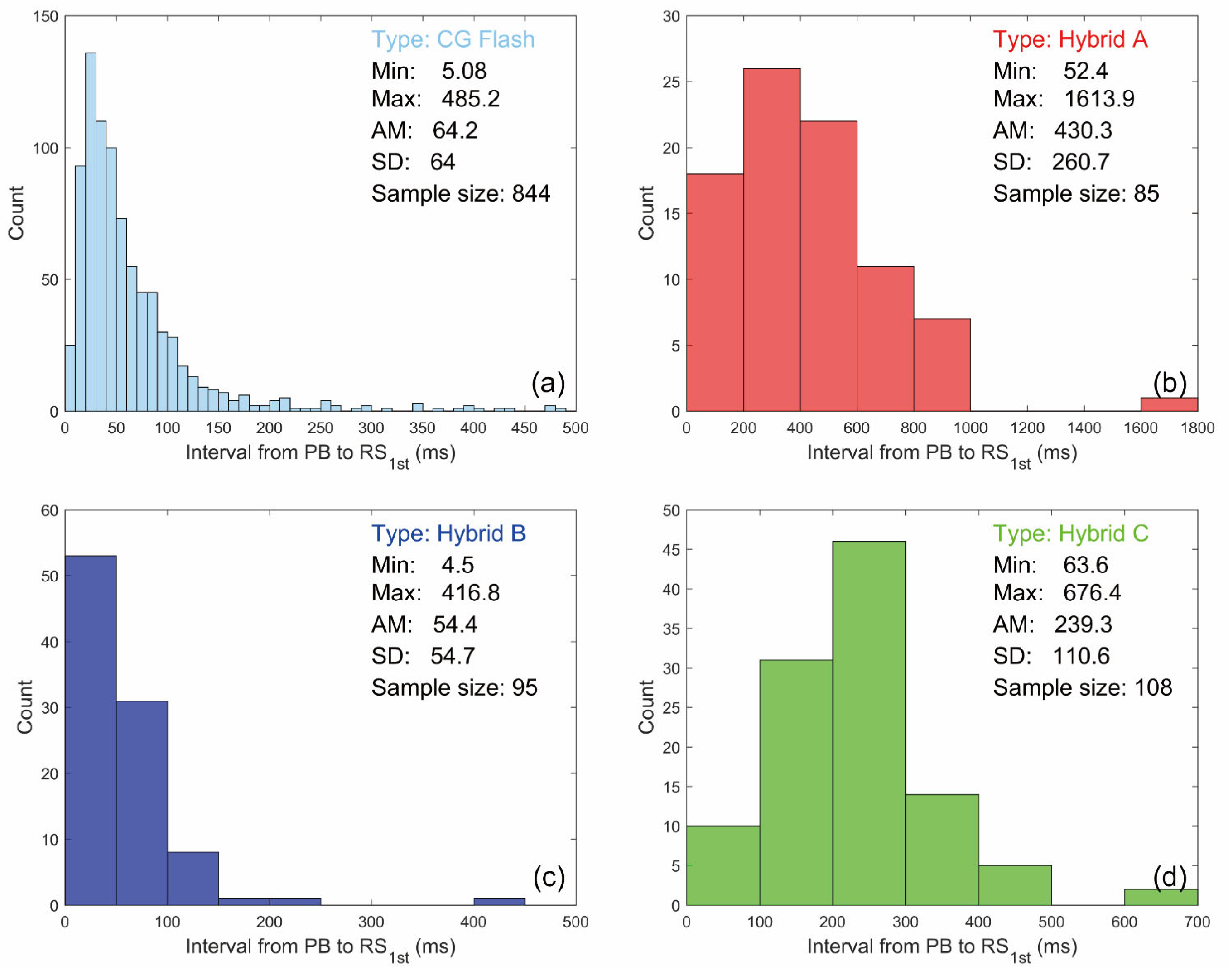

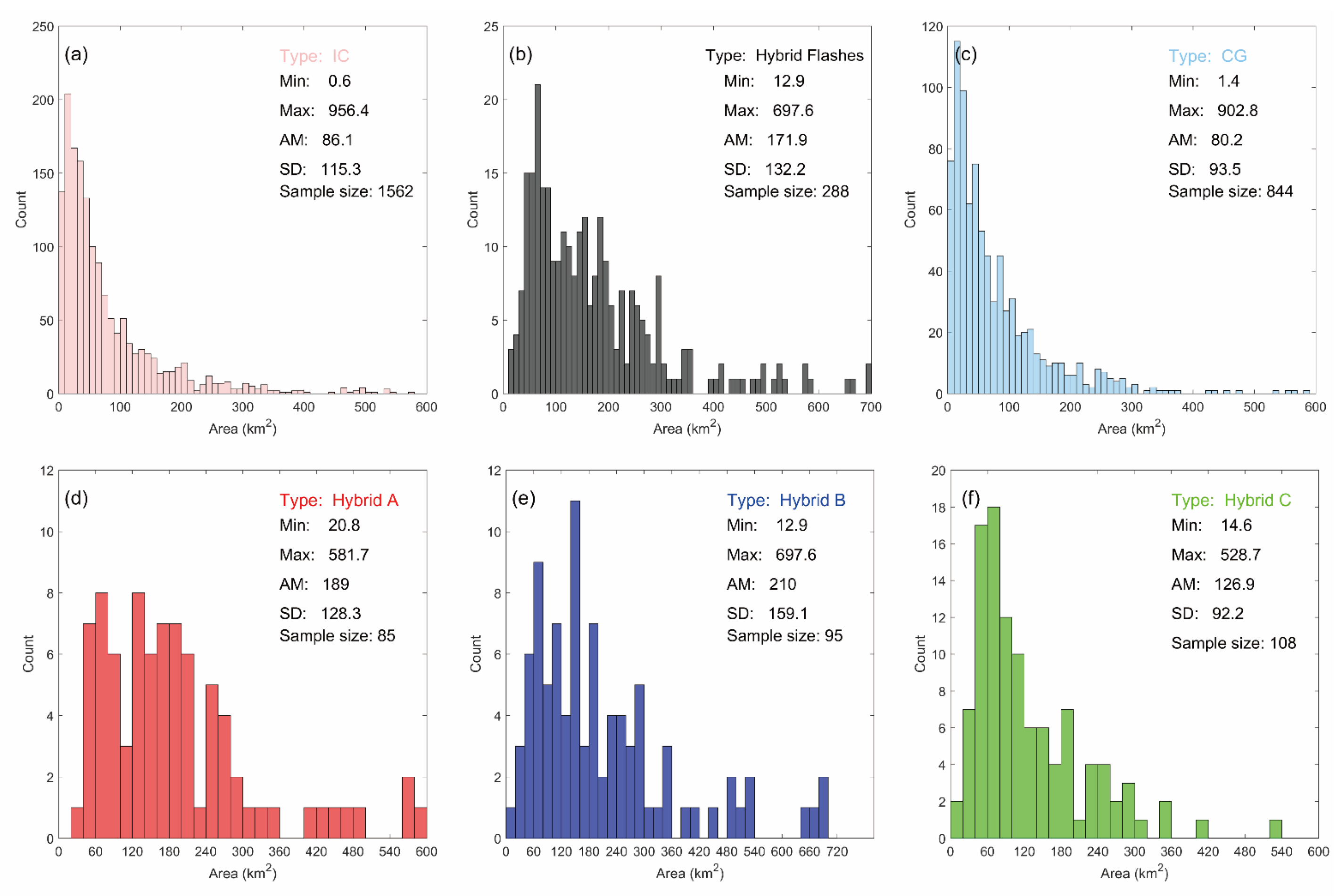

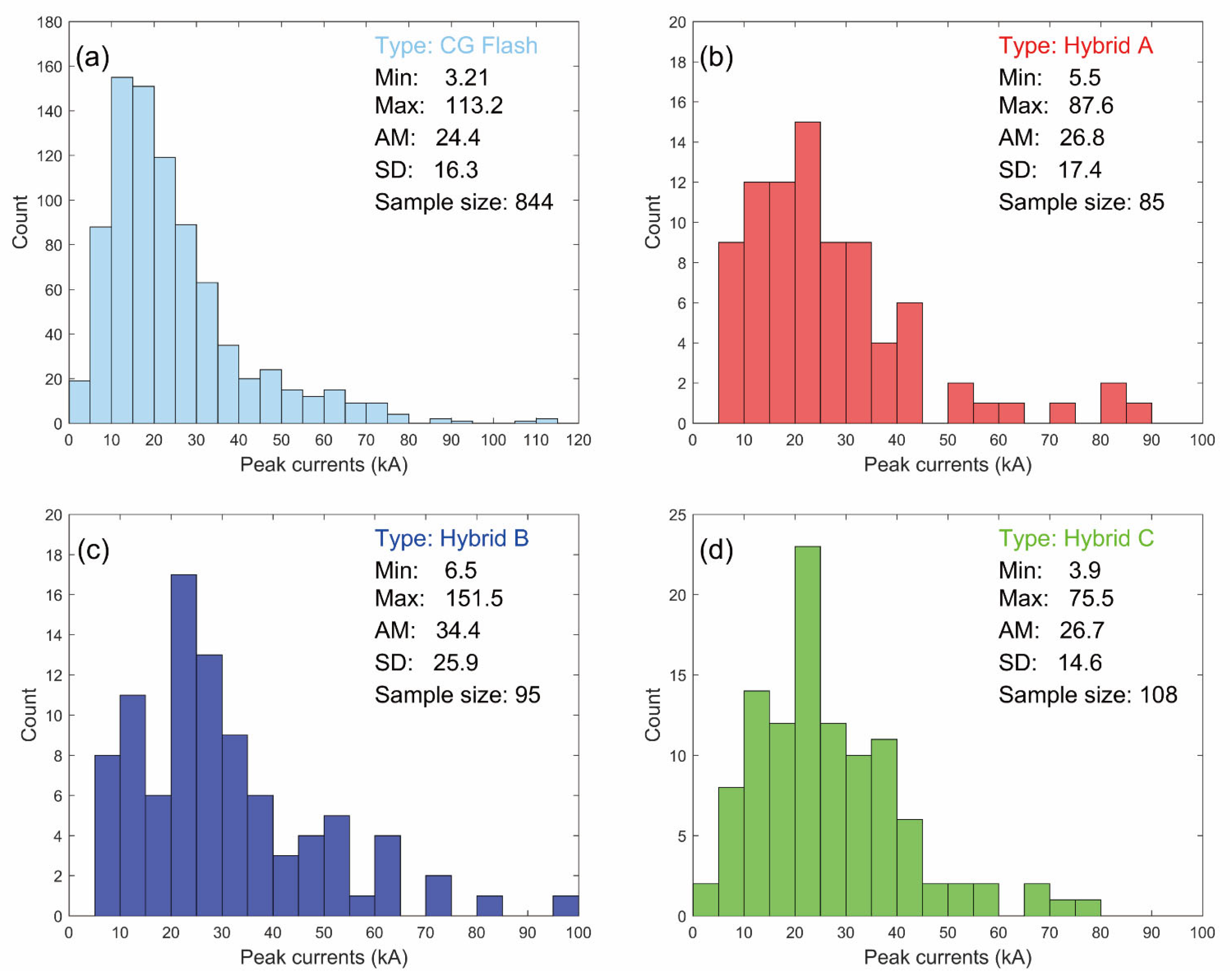
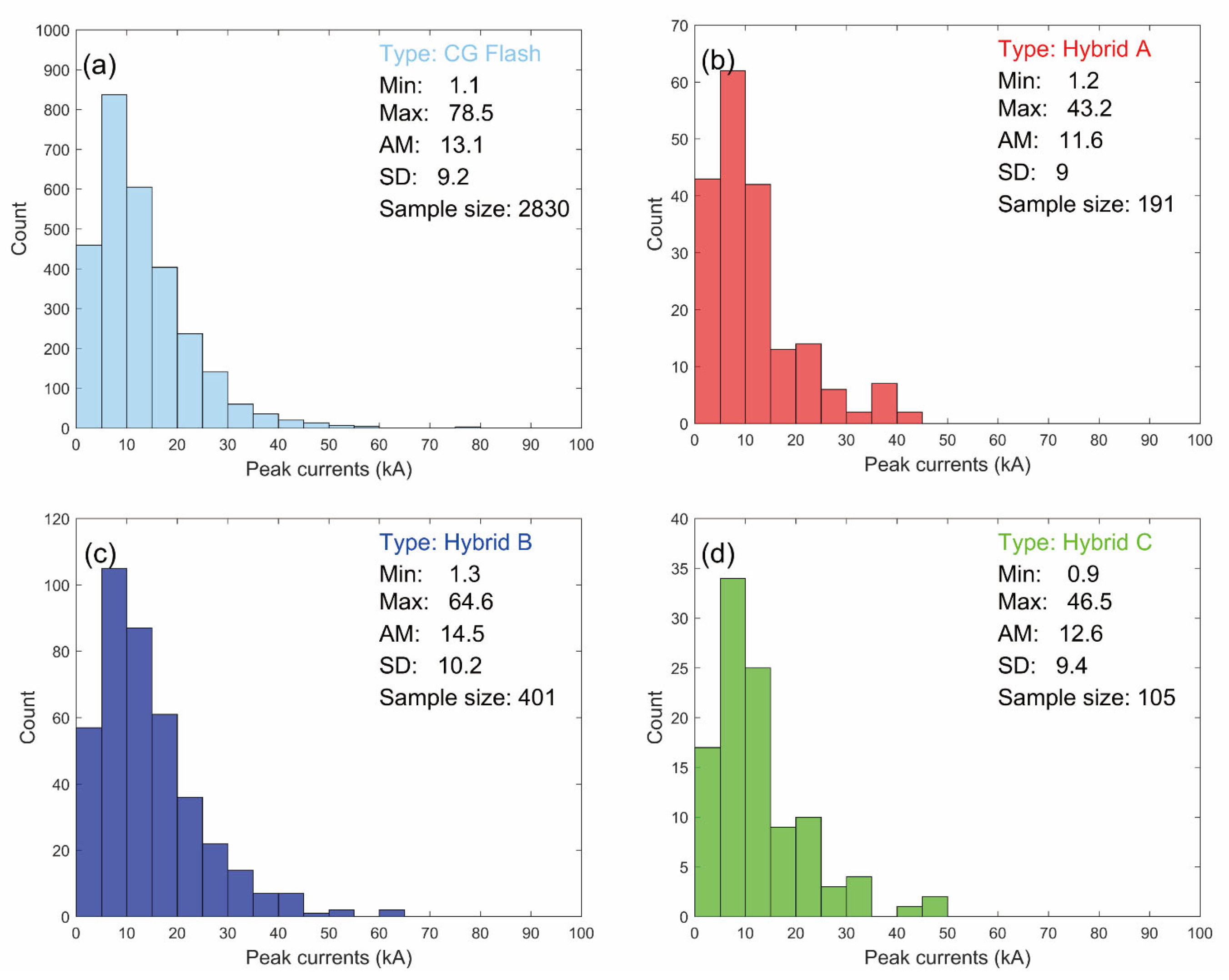
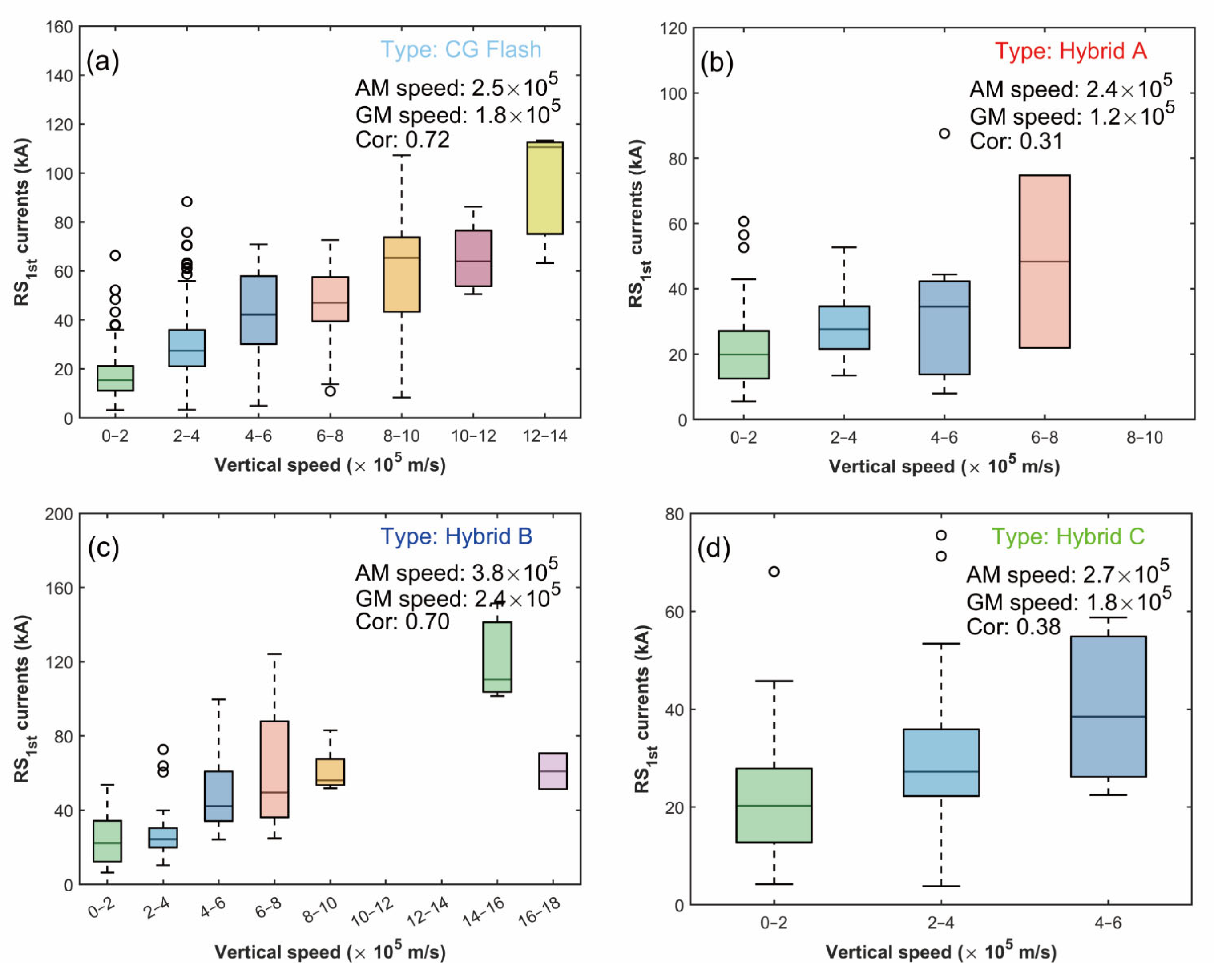

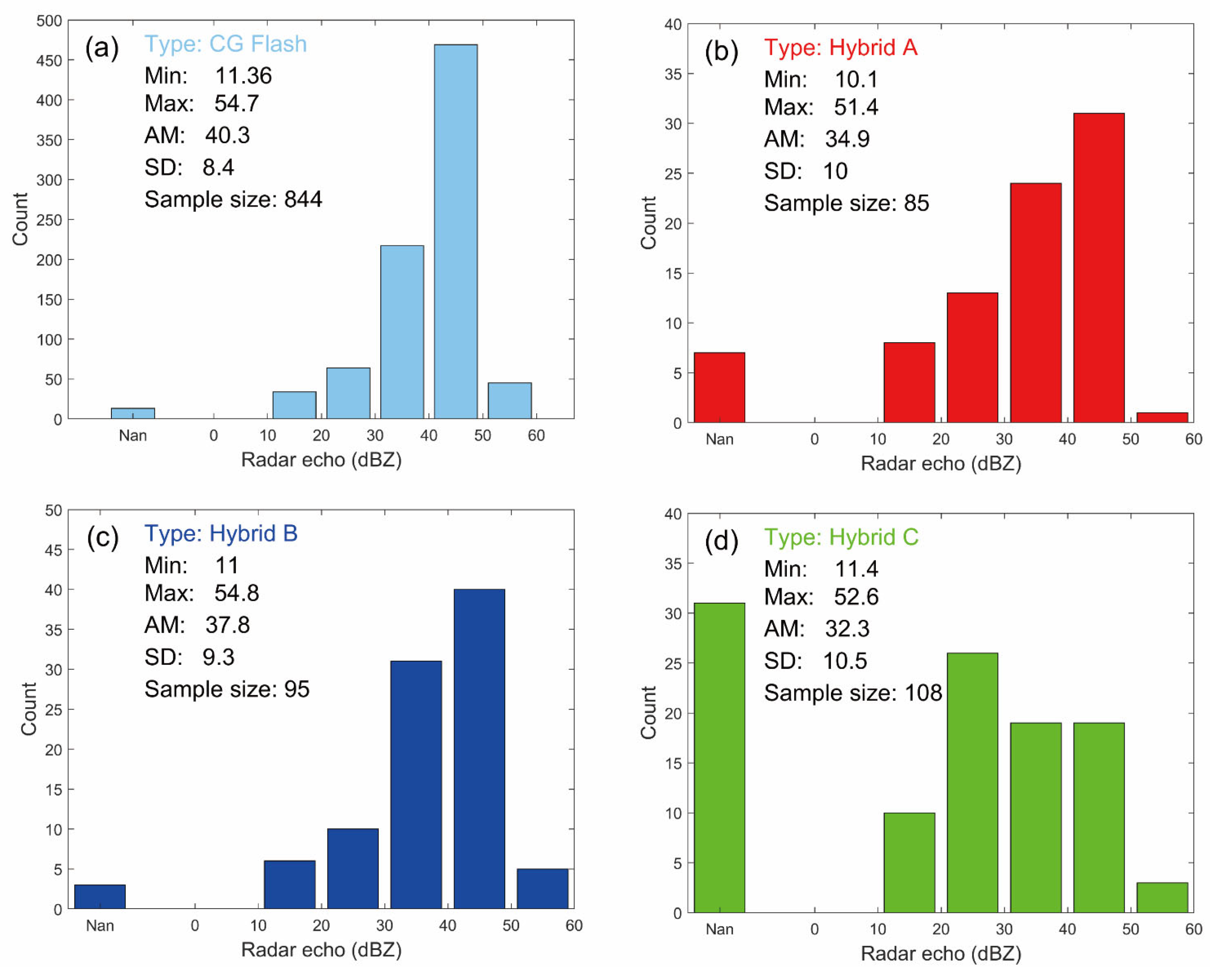

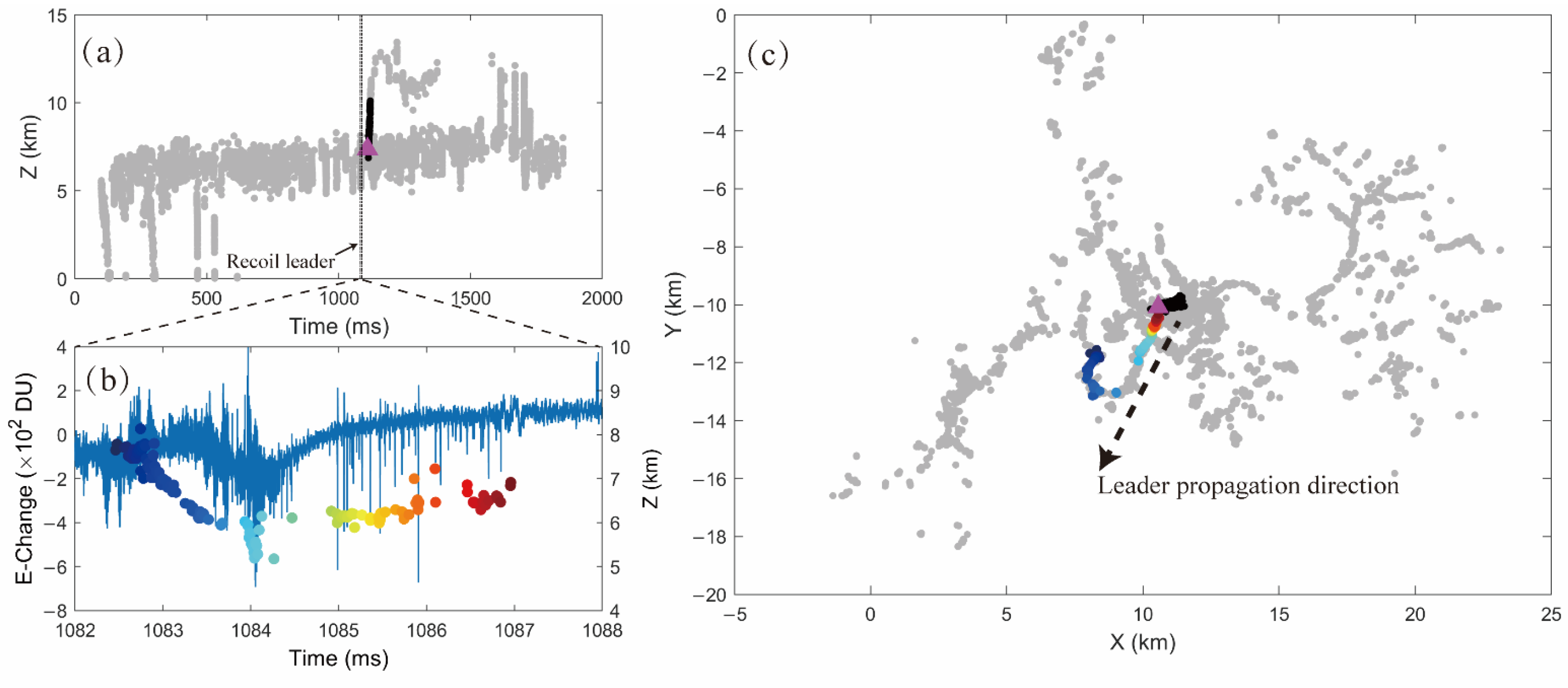

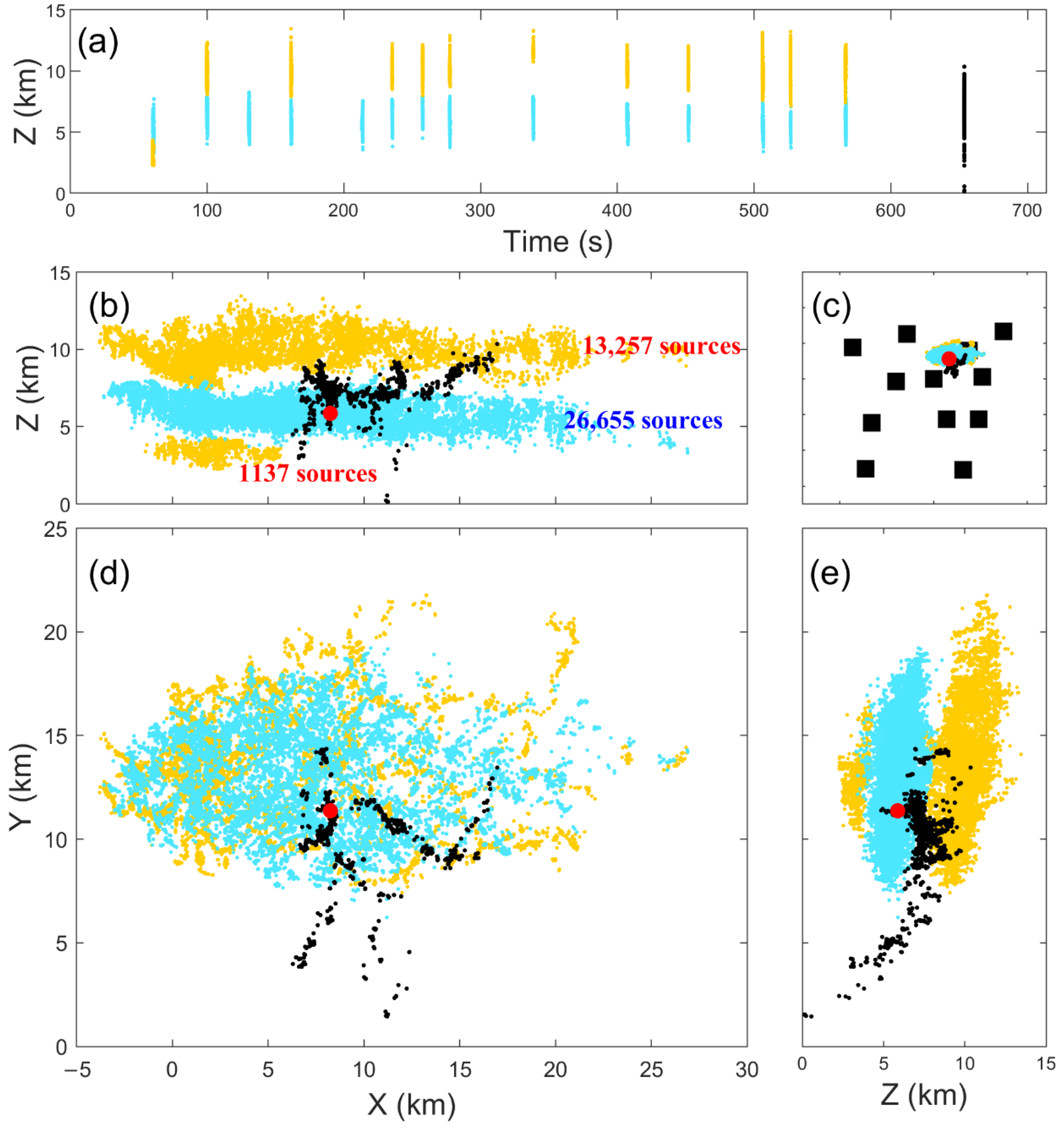
Disclaimer/Publisher’s Note: The statements, opinions and data contained in all publications are solely those of the individual author(s) and contributor(s) and not of MDPI and/or the editor(s). MDPI and/or the editor(s) disclaim responsibility for any injury to people or property resulting from any ideas, methods, instructions or products referred to in the content. |
© 2025 by the authors. Licensee MDPI, Basel, Switzerland. This article is an open access article distributed under the terms and conditions of the Creative Commons Attribution (CC BY) license (https://creativecommons.org/licenses/by/4.0/).
Share and Cite
Shi, D.; Shao, J.; Jiang, R.; Wang, D.; Wu, T.; Wang, L. Characterization of Hybrid Lightning Flashes Observed by Fast Antenna Lightning Mapping Array in Summer Thunderstorms. Atmosphere 2025, 16, 765. https://doi.org/10.3390/atmos16070765
Shi D, Shao J, Jiang R, Wang D, Wu T, Wang L. Characterization of Hybrid Lightning Flashes Observed by Fast Antenna Lightning Mapping Array in Summer Thunderstorms. Atmosphere. 2025; 16(7):765. https://doi.org/10.3390/atmos16070765
Chicago/Turabian StyleShi, Dongdong, Jie Shao, Rubin Jiang, Daohong Wang, Ting Wu, and Li Wang. 2025. "Characterization of Hybrid Lightning Flashes Observed by Fast Antenna Lightning Mapping Array in Summer Thunderstorms" Atmosphere 16, no. 7: 765. https://doi.org/10.3390/atmos16070765
APA StyleShi, D., Shao, J., Jiang, R., Wang, D., Wu, T., & Wang, L. (2025). Characterization of Hybrid Lightning Flashes Observed by Fast Antenna Lightning Mapping Array in Summer Thunderstorms. Atmosphere, 16(7), 765. https://doi.org/10.3390/atmos16070765





